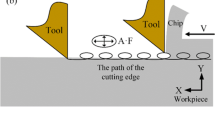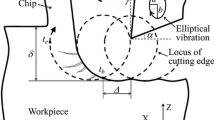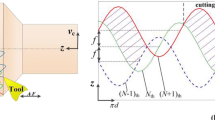Abstract
Longitudinal ultrasonic vibration-assisted machining (LUVAM) is a machining technique that offers several benefits such as low cutting force, good surface quality, and prolonged tool life. A new set of LUVAM spindle with high-frequency vibrations was designed to enhance the efficiency of LUVAM and the critical cutting speed of "tool-workpiece separation." The spindle's stepped axial vibration transducer is designed analytically, and its amplitude is amplified. The spindle's performance was assessed by measuring resonant frequencies and amplitudes of tungsten carbide and high speed steel tool at varying lengths. Experimental results showed that the transducer's maximum resonance frequency was around 33.52 kHz, and its maximum amplitude was approximately 24.03 μm. The maximum spindle speed exceeded 20,000 rpm, and the runout error was low during high-speed operations. Additionally, Inconel 718 was machined with the new spindle, and the experimental cutting force, machining temperature, surface morphology, chip, and surface integrity were analyzed under different machining parameters. The test results showed that LUVAM could successfully reduce cutting force and temperature while improving surface integrity when separation conditions are met. Compared to conventional machining, LUVAM reduced cutting force and average cutting temperature by up to 23.3% and 19.8%, respectively. The new spindle design provides a new approach for high-quality, efficient, and eco-friendly machining of difficult-to-cut materials.






















Similar content being viewed by others
Data availability
Data and material availability are available upon request from the authors.
Code availability
The code is available from the authors upon request.
References
Sonar T, Balasubramanian V, Malarvizhi S, Venkateswaran T, Sivakumar D (2021) An overview on welding of Inconel 718 alloy - Effect of welding processes on microstructural evolution and mechanical properties of joints. Mater Charact 174:110997. https://doi.org/10.1016/j.matchar.2021.110997
Rahman M, Seah WKH, Teo TT (1997) The machinability of inconel 718. J Mater Process Technol 63(1–3):199–204. https://doi.org/10.1016/s0924-0136(96)02624-6
Jafarian F, Imaz Ciaran M, Umbrello D, Arrazola PJ, Filice L, Amirabadi H (2014) Finite element simulation of machining Inconel 718 alloy including microstructure changes. Int J Mech Sci 88:110–121. https://doi.org/10.1016/j.ijmecsci.2014.08.007
Teti R (2002) Machining of Composite Materials. CIRP Ann 51(2):611–634. https://doi.org/10.1016/s0007-8506(07)61703-x
Yang Z, Zhu L, Zhang G, Ni C, Lin B (2020) Review of ultrasonic vibration-assisted machining in advanced materials. Int J Mach Tools Manuf 103594. https://doi.org/10.1016/j.ijmachtools.2020.103594
Brehl DE, Dow TA (2008) Review of vibration-assisted machining. Precis Eng 32(3):153–172. https://doi.org/10.1016/j.precisioneng.2007.08.003
Chen W, Huo D, Shi Y, Hale JM (2018) State-of-the-art review on vibration-assisted milling: principle, system design, and application. Int J Adv Manuf Technol 97(5–8):2033–2049. https://doi.org/10.1007/s00170-018-2073-z
Ning F, Cong W (2020) Ultrasonic vibration-assisted (UV-A) manufacturing processes: State of the art and future perspectives. J Manuf Process 51:174–190. https://doi.org/10.1016/j.jmapro.2020.01.028
Liu X, Wu D, Zhang J et al (2019) Analysis of surface texturing in radial ultrasonic vibration-assisted turning. J Mater Process Technol 267:186–195. https://doi.org/10.1016/j.jmatprotec.2018.12.021
Yan L, Zhang X, Li H, Zhang Q (2022) Machinability improvement in three-dimensional (3D) ultrasonic vibration assisted diamond wire sawing of SiC. Ceram Int 48:6. https://doi.org/10.1016/j.ceramint.2021.12.006
Yang T, Fang X, Hang Y, Xu Z, Zeng Y (2021) Workpiece vibration in feed direction assisted electrochemical cutting using tube electrode with inclined holes. Int J Adv Manuf Technol 116(7–8):2651–2660. https://doi.org/10.1007/s00170-021-07556-8
Luo H, Wang Y, Zhang P (2020) Effect of cutting and vibration parameters on the cutting performance of 7075-T651 aluminum alloy by ultrasonic vibration. Int J Adv Manuf Technol. https://doi.org/10.1007/s00170-020-05098-z
Liu Y, Liu Z, Wang X, Huang T (2020) Experimental study on tool wear in ultrasonic vibration–assisted milling of C/SiC composites. Int J Adv Manuf Technol. https://doi.org/10.1007/s00170-020-05060-z
Choi Y-J, Park K-H, Hong Y-H, Kim K-T, Lee S-W, Choi H-Z (2013) Effect of ultrasonic vibration in grinding; horn design and experiment. Int J Precis Eng Manuf 14(11):1873–1879. https://doi.org/10.1007/s12541-013-0253-1
Wu Y, Yokoyama S, Sato T, Lin W, Tachibana T (2009) Development of a new rotary ultrasonic spindle for precision ultrasonically assisted grinding. Int J Mach Tools Manuf 49(12–13):933–938. https://doi.org/10.1016/j.ijmachtools.2009.06.012
Greco S, Kirsch B and Aurich J C (2018) Vibration-assisted air bearing spindle for micro machining - development of a magnetic field controlled ultrasonic actuator. Proceedings of the 18th euspen International Conference 141–142
Wu C, Chen S, Cheng K, Ding H, Xiao C (2018) Innovative design and analysis of a longitudinal-torsional transducer with the shared node plane applied for ultrasonic assisted milling. Proc Inst Mech Eng C J Mech Eng Sci. https://doi.org/10.1177/0954406218797962
Gao J, Caliskan H, Altintas Y (2019) Sensorless control of a three-degree-of-freedom ultrasonic vibration tool holder. Precis Eng. https://doi.org/10.1016/j.precisioneng.2019.05.005
Haili J, Chen W, Fan K, Hua Z (2020) Design and simulation analysis of ultrasonic extrusion transducer. 2020 3rd World Conference on Mechanical Engineering and Intelligent Manufacturing (WCMEIM) 802–805. https://doi.org/10.1109/WCMEIM52463.2020.00171
Feng Y, Hsu F-C, Lu Y-T, Lin Y-F, Lin C-T, Lin C-F, Lu Y-C, Liang SY (2020) Temperature prediction of ultrasonic vibration-assisted milling. Ultrasonics p. 106212. https://doi.org/10.1016/j.ultras.2020.106212
Feng Y, Hsu F-C, Lu Y-T, Lin Y-F, Lin C-T, Lin C-F, Lu Y-C, Liang SY (2020) Force prediction in ultrasonic vibration-assisted milling. Mach Sci Technol 25. https://doi.org/10.1080/10910344.2020.1815048
Feng Y, Hsu F-C, Lu Y-T, Lin Y-F, Lin C-T, Lin C-F, Lu Y-C, Lu X, Liang SY (2020) Surface roughness prediction in ultrasonic vibration-assisted milling. J Adv Mech Des Syst Manuf 14(4):JAMDSM0063. https://doi.org/10.1299/jamdsm.2020jamdsm0063
Amin SG, Ahmed MHM, Youssef HA (1995) Computer-aided design of acoustic horns for ultrasonic machining using finite-element analysis. Journal of Materials Processing Tech 55(3-4):254–260. https://doi.org/10.1016/0924-0136(95)02015-2
Kumar Patel L, Kumar Singh A, Sharma V, Kala P (2020) Analysis of a hybrid ultrasonic horn profile using finite element analysis. Mater Today: Proc. https://doi.org/10.1016/j.matpr.2020.08.465
Mughal KH, Qureshi MAM, Raza SF (2021) Novel ultrasonic horn design for machining advanced brittle composites: A step forward towards green and sustainable manufacturing. Environ Technol Innov 23:101652. https://doi.org/10.1016/j.eti.2021.101652
Chen W, Huo D, Hale J, Ding H (2018) Kinematics and tool-workpiece separation analysis of vibration assisted milling. Int J Mech Sci 136:169–178. https://doi.org/10.1016/j.ijmecsci.2017.12.037
Pengfei D, La H, Qiu X, Chen W, Deng J, Liu Y, Zhang J (2022) Development of a high-precision piezoelectric ultrasonic milling tool using longitudinal-bending hybrid transducer. Int J Mech Sci. https://doi.org/10.1016/j.ijmecsci.2022.107239
Shokrani, Dhokia V, Newman ST, Imani-Asrai R (2012) An Initial Study of the Effect of Using Liquid Nitrogen Coolant on the Surface Roughness of Inconel 718 Nickel-Based Alloy in CNC Milling. Procedia CIRP 3:121–125. https://doi.org/10.1016/j.procir.2012.07.022
Touazine H, Jahazi M, Bocher P (2016) Accurate determination of damaged subsurface layers in machined Inconel 718. Int J Adv Manuf Technol 88(9–12):3419–3427. https://doi.org/10.1007/s00170-016-9039-9
Xu M, Li C, Kurniawan R et al (2022) Ultrasonic and electrical discharge–assisted milling of the Ti-6Al-4 V alloy. Int J Adv Manuf Technol 122:1897–1917. https://doi.org/10.1007/s00170-022-10010-y
Dongliang X (2012) Study on tribological properties of surfaces machined by ultrasonic vibration assisted milling. Shandong University, Shandong
Jie L, Zhu S-s, Xiao-lan X, Xin D (2021) Cutting Performance of AlCrSiN Coated Tool in Dry Turning Ti-6Al-4V Titanium Alloy. Journal of Guangdong University of Technology 38(02):99–106. https://doi.org/10.3390/mi11020137
Baoqi C, Zhaoxi Y, Xiaobing C, Ji-an D (2022) Surface feature and material removal in ultrasonic vibration-assisted slot-milling of Ti–6Al–4 V titanium alloy. Int J Adv Manuf Technol 122:2235–2251. https://doi.org/10.1007/s00170-022-09970-y
Guo S, Du W, Jiang Q, Dong Z, Zhang B (2021) Surface Integrity of Ultrasonically-Assisted Milled Ti6Al4V Alloy Manufactured by Selective Laser Melting. Chinese J Mech Eng 34(1). https://doi.org/10.1186/s10033-021-00586-z
Liang X, Liu Z, Chen L, Hao G, Wang B, Cai Y, Song Q (2020) Tool wear induced modifications of plastic flow and deformed material depth in new generated surfaces during turning Ti-6Al-4V. J Mater Res Technol 9(5):10782–10795. https://doi.org/10.1016/j.jmrt.2020.07.093
Funding
This research was supported by the National Research Foundation of Korea (NRF) grant funded by the Korean government (MSIT) (2020R1A2B5B02001755). Also, this research was funded by the Ministry of Science and ICT (MSIT) through the Korea Electrotechnology Research Institute's (KERI) primary research program through the National Research Council of Science and Technology (NST) in 2023. (No. 23A01021).
Author information
Authors and Affiliations
Contributions
Moran Xu: Conceptualization, Investigation, Experiments, Software, Writing- Preparation of the first draft, Visualization. Shuo Chen: Formal analysis, Investigation, Visualization. Rendi Kurniawan: Supervision, Validation. Changping Li: Conceptualization, Methodology, Resources. Ye In Kwak: Data curation. Saood Ali: Visualization. Min Ki Choo: Data curation. Pil-Wan Han: Software. Tae Jo Ko: Conceptualization, Resources, Visualization, Supervision, Project administration, Funding acquisition
Corresponding authors
Ethics declarations
Consent to participate
This is not applicable.
Ethics approval
This is not applicable.
Consent for publication
This is not applicable.
Conflict of interest
The authors declare no competing interests. The authorship and funding have been declared properly.
Additional information
Publisher’s note
Springer Nature remains neutral with regard to jurisdictional claims in published maps and institutional affiliations.
Rights and permissions
Springer Nature or its licensor (e.g. a society or other partner) holds exclusive rights to this article under a publishing agreement with the author(s) or other rightsholder(s); author self-archiving of the accepted manuscript version of this article is solely governed by the terms of such publishing agreement and applicable law.
About this article
Cite this article
Xu, M., Chen, S., Kurniawan, R. et al. Enhancement of Machinability Study in Longitudinal Ultrasonic Vibration-assisted Milling Inconel 718 Using High-frequency-vibration Spindle. Int J Adv Manuf Technol 126, 3523–3542 (2023). https://doi.org/10.1007/s00170-023-11319-y
Received:
Accepted:
Published:
Issue Date:
DOI: https://doi.org/10.1007/s00170-023-11319-y




